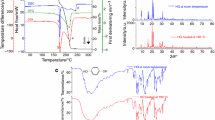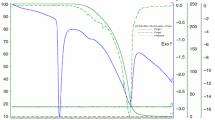Abstract
The 4,6-bis[2′(diethylamino)ethoxy]2,8,10-trimethylpyrido[3,2-g]quinoline (BG 637) is one of the compound from the pyrido[3,2-g] quinolines family. This compound had in vitro activity against the resistant cells and can reverse the multidrug resistance developed during the chemotherapeutic treatments.
To characterize BG 637, techniques such as differential scanning calorimetry (DSC), Fourier transform infrared spectrometer (FTIR), ultra violet spectrophotometry (UV), gas chromatography coupled with mass spectrometry (GC/MS), nuclear magnetic resonance (NMR) and X-ray powder diffraction (XRPD) were used. Several of them were also used to show the stability of the drug during various storage conditions.
DSC, FTIR and UV were used as screening techniques for assessing the compatibility of BG 637 with several commonly used pharmaceutical excipients. We compared the properties of the pure drug with those of binary mixture drug/excipient. Studied excipients were lactose monohydrate, microcrystalline cellulose, polyvinylpyrrolidone, sodium croscarmellose and magnesium stearate. Melting temperature and enthalpy of BG 637 in binary mixtures were similar to theoretical values. These results showed that BG 637 is a very stable compound and compatible with several pharmaceutical excipients.
Similar content being viewed by others
References
E. Teodori, S. Dei, S. Scapecchi and F. Gualtieri, Il Farmaco, 57 (2002) 385.
M. Volm and J. Mattern, Crit. Rev. Oncog., 7 (1996) 227.
P. Olliaro, Pharmacol. Ther., 89 (2001) 207.
T. Tsuruo, H. Iida, S. Tsukagoshi and Y. Sakurai, Cancer Research, 41 (1981) 1967.
C. Matias, A. Mahamoud, J. Barbe, B. Pradine and J. C. Doury, Heterocycles, 43 (1996) 1621.
ICH Harmonised Tripartite Guideline, Stability Testing of New Drug Substances and Products, ICH Q1A(R2). The European Agency for the Evaluation of Medicinal Products (CPMP/ICH/2736/99), 2003.
R. C. Rowe, P. J. Sheskey and P. J. Weller, Handbook of Pharmaceutical Excipients, 4th Ed., Pharmaceutical Press (PhP) and American Pharmaceutical Association (APhA), London and Chicago 2003.
A. R. Gennaro, Ed., Remington’s Pharmaceutical Sciences, 18th Ed., Mack Publishing Company., Easton PA 1990.
A. E. Aboutaleb, A. M. Attia and F. S. Habib, Pharmazie, 38 (1983) 473.
H. A. Liebermann, L. Lachman and J. B. Schwartz, Pharmaceutical Dosage Forms: Tablets, 2nd Revised and Expanded Ed., 1996.
O. A. Itiola and N. Pilped, Int. J. Pharm., 31 (1986) 99.
S. Y. Lin, J. Pharm. Sci., 77 (1988) 229.
Z. T. Chowhan, Pharm. Technol., 17 (1993) 72.
P. C. Mora, M. Cirri and P. Mura, J. Pharm. Biomed. Anal., 42 (2006) 3.
A. A. Araujo, S. Storpirtis, L. P. Mercuri, F. M. Carvalho, M. dos Santos Filho and J. R. Matos, Int. J. Pharm., 260 (2003) 303.
EDQM and European Directorate for the Quality of Medicines and Health Care, European Pharmacopoeia, 6th Ed., Council of Europe, Strasbourg 2008.
I. I. Jivraj, L. G. Martini and C. M. Thomson, Pharm. Sci. Technol. Today, 3 (2000) 58.
United States Pharmacopoeia-National Formulary, USP 30-NF 25, Rockville 2007.
C. L. Winek, Drugs Pharm. Sci., 103 (2000) 59.
ICH Harmonised Tripartite Guideline, Impurities: Residual Solvents, ICH Q3C(R3). The European Agency for the Evaluation of Medicinal Products (CPMP/ICH/283/95), 1997.
P. Bracconi, C. Andres, A. N’Diaye and Y. Pourcelot, Thermochim. Acta, 429 (2005) 43.
P. Bracconi, C. Andres and A. N’Diaye, Int. J. Pharm., 262 (2003) 109.
S. Sharpe, M. Celik, A. Newman and H. Brittain, Struct. Chem., 8 (1997) 73.
P. Crowley and L. Martini, Pharm. Technol. Eur., 13 (2001), 26–28 see also 30–32, 34.
S. Byrn, R. Pfeiffer, M. Ganey, C. Hoiberg and G. Poochikian, Pharm. Res., 12 (1995) 945.
H. G. Brittain, S. J. Bogdanowich, D. E. Bugay, J. DeVincentis, G. Lewen and A. W. Newman, Pharm. Res., 8 (1991) 963.
ICH Harmonised Tripartite Guideline, Pharmaceutical Development, ICH Q8. The European Agency for the Evaluation of Medicinal Products (CPMP/ICH/167068/04), 2005.
G. G. G. Oliveira, H. G Ferraz and J. S. R. Matos, J. Therm. Anal. Cal., 79 (2005) 267.
M. Laszcz, B Kosmacinska, K. Korczak, B. Simigielska, M. Glice, W. Maruszak, A. Groman, H. Beczkowicz and L. Zelazko, J. Therm. Anal. Cal., 88 (2007) 305.
Author information
Authors and Affiliations
Corresponding author
Rights and permissions
About this article
Cite this article
Abbas, D., Kaloustian, J., Orneto, C. et al. DSC and physico-chemical properties of a substituted pyridoquinoline and its interaction study with excipients. J Therm Anal Calorim 93, 353–360 (2008). https://doi.org/10.1007/s10973-008-9062-7
Received:
Accepted:
Published:
Issue Date:
DOI: https://doi.org/10.1007/s10973-008-9062-7




